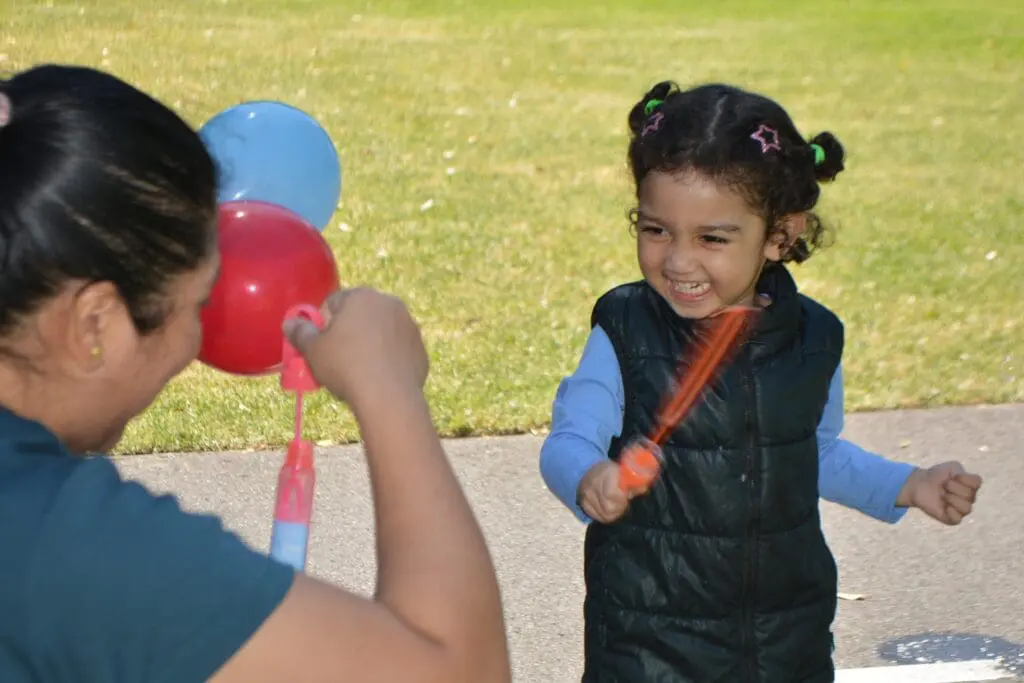Resources for Families

Activities for Children
Kickstart your child’s success with the below activities.
These DIY resources were created with the support of the Australian Government Department of Social Services, through the Strong and Resilient Communities Program.
The Multicultural Children’s Games were collated through a project funded under the South Australian Government Statewide Wellbeing Strategy, led by Wellbeing SA.

DIY Skittles / Bowling at Home
A simple, indoor bowling game made from recycled materials where children roll empty cans or container lids to knock down a set of plastic bottles, helping develop hand-eye coordination while having fun at home.

DIY Quoits / Ring Toss at Home
A classic ring toss game made at home using paper rings created from old magazines and empty glass bottles, where children test their aim and accuracy by throwing the handmade rings to land them around the bottle necks.

DIY Indoor Hockey at Home
A creative indoor sport activity where children make their own hockey sticks from cardboard rolls and recycled paper, then practice their shooting skills by hitting bottle targets or playing a simplified version of hockey at home.

DIY ‘Shoot At The Basket’ / Cup Toss at Home
A simple target-practice game where children throw bottle caps into plastic containers positioned at different distances, helping develop hand-eye coordination and precision while using everyday recycled materials.

Create a DIY phone / tablet / book stand, using cardboard
A creative craft project where children, with the help of their grown ups, transform cardboard into a stand for phones, tablets or books, combining recycled materials with imagination to make a practical and decorative holder while practicing cutting and folding skills.

Rybalka Fishing
(from Ukraine)
A lively traditional Ukrainian game where one player (the Fisherman) spins a rope in a circle while others (the Fish) jump over it, testing reflexes and coordination as players try to avoid being ‘caught’ by the rope, with the last player remaining becoming the new Fisherman.

Bachiderato (Tutti Frutti)
(from Chile)
A popular South American word game, known by different names across the continent, including ‘Tutti Frutti’ in Chile, where players race to fill in categories like names, fruits, and animals with words beginning with a chosen letter, earning points for unique answers and sharing the excitement of calling “stop!” when finished.

Shells Game
(from Fiji)
A traditional Fijian beach game where players toss and flick similar-sized shells, first trying to land them all facing the same way to start scoring, then testing their accuracy by flicking shells to hit targets, combining luck and skill in a game that originated from the island’s abundant seashells.

Topfschlagen
(from Germany)
A beloved German birthday party game where blindfolded children crawl around tapping the ground with a wooden spoon, guided by others calling “hot” or “cold,” as they search for a hidden pot concealing a treat, creating excitement and laughter as players use their listening skills to find their prize.

Kash
(from Iran)
A traditional jumping game popular in rural Iran and many other countries, where two players hold an elastic loop while others perform increasingly challenging jumps as the elastic is raised from ankle to thigh height, testing agility and coordination in a simple yet engaging activity that requires only a length of elastic.

Strega Comanda Color
(from Italy)
A lively Italian running game where one player, the “Witch,” calls out a colour and chases others as they scramble to touch something of that colour to stay safe, combining the excitement of tag with colour recognition in a simple but energetic playground favourite that needs no equipment.

Baddy Safer Ala
(from Lebanon)
A creative Lebanese playground game where one player, the Traveller, stands in a chalked circle surrounded by other players representing different countries, then tries to reach each “country” in a predicted number of steps, combining geography learning with strategy as children imagine journeying across the world.

Botkidi
(from Sierra Leone)
A traditional street game from Sierra Leone where players throw bottle lids at a chalked square, then use sticks to hit opponents’ lids away or towards the target, combining throwing accuracy and striking skills in an energetic game that was a competitive favourite among neighbourhood children in the 1980s.

Kopara Kopara Pipinya
(from Sri Lanka)
A traditional Sri Lankan New Year game where children sit in a circle with closed eyes while one player walks around singing “Kopara Kopara,” taps someone with a leafy branch, then races to claim their spot before being caught, creating excitement through chase and surprise in a game passed down through generations.
Parenting Resources
Being a parent, guardian or carer in Australia might be different from your home country. The rules about raising our children here may not be what you expect.
Parenting SA
Parenting SA provides resources and support for parents and caregivers, informed by evidence and best practice, such as free Parent Easy Guides, free parenting seminars in Adelaide (including webcasts and seminar recordings), and parenting videos.
Parenting SA acknowledge the diversity of families and cultures in our community, and provide valuable resources and information for Multicultural Families. More general parenting information, support and resources are also available.
Many of their Parent Easy Guides are available in languages other than English, including Arabic, Dari, Dinka, French, Swahili, Uyghur, Nepali, Karen and Kirundi.
Some Easy Guides we found really helpful include:
- Being a dad – Multicultural Parent Easy Guide (English)
- Children in Australia – Multicultural Parent Easy Guide (English)
- Early and forced marriage – Multicultural Parent Easy Guide (English)
- Female genital cutting – Multicultural Parent Easy Guide (English)
- Keeping children safe – Multicultural Parent Easy Guide (English)
- Parenting in Australia – Multicultural Parent Easy Guide (English)
- Strong families – Multicultural Parent Easy Guide (English)
- Support Services – Multicultural Parent Easy Guide (English)
- Teenagers in Australia – Multicultural Parent Easy Guide (English)
These ‘Multicultural Parent’ guides can be found in other languages on the Parenting SA website.
They are also available in hard copies for free via the Parenting SA Shop.
Contact Parenting SA for more information and support:
Address: 295 South Terrace, Adelaide, 5000
Phone (08) 8303 1660
Email:[email protected]
Department of Education
The SA Government’s Department of Education also provides a range of support, information and resources for parents and families.
Additionally, the Department of Education’s Multicultural Education and Languages Committee (MELC) is a ministerial advisory committee responsible for providing advice to the South Australian Minister for Education, Training and Skills on the interrelated areas of languages education, multicultural education and the internationalisation of education.
Child Safety Resources
Keeping our children safe is very important. Many injuries that bring children to hospitals could be stopped by making simple safety changes at home.
Kidsafe SA
Kidsafe SA is dedicated to preventing unintentional injuries and deaths in children under 15 years old, through education, advocacy, and safety initiatives.
They have many great free resources, including:
- Translated Resources, available in: Arabic, Bengali, Burmese, Chinese (simplified), Chinese (traditional), Dari, Dinka, Farsi, French, Hindi, Indonesian, Italian, Japanese, Korean, Nepali, Portuguese, Russian, Spanish, Thai, and Vietnamese
- Home Safety Checklist (.pdf)
- A range of Easy to Read Fact Sheets and more comprehensive information sheets
- Information and Resources about Burns
- Information and Resources on Playground Safety
- Information and Resources for Home Safety
- A Parents Guide to Kidsafe Roads (.pdf)
- Keeping Children Safe: a guide on Injury Prevention (.pdf)
Contact Kidsafe SA for more information and support:
Phone: (08) 7089 8554
Email: [email protected]
Royal Life Saving Australia
Royal Life Saving Australia is dedicated to drowning prevention through water safety education, research, and community programs, safety initiatives and swimming education programs.
- Information on Water Safety for Multicultural Communities
- How to Keep Children Safe Around Water
- Information about specific locations, including:
Domestic & Family Violence
Domestic and family violence affects people of all cultural backgrounds, ages, genders, religions and sexual orientations. If you’re experiencing abuse, you’re not alone. Support is available for everyone in Australia, including those from culturally diverse communities.
Need help? (For people currently experiencing violence or in crisis)
If you’re in immediate danger, call 000
For 24/7 counselling and support, call 1800RESPECT (1800 737 732)
To speak to someone in your language, call the Translating and Interpreting Service (TIS) on 131 450
I’m a young person and need to leave home because of violence. What help can I get?
If you’re under 18 and need to leave home:
- Call Kids Helpline on 1800 55 1800. They can talk to you about your situation.
- They can help you find a safe place to stay.
- Visit our support services page for more help options.
Remember, it’s not your fault, and you deserve to be safe.
How can I safely get my things from home after leaving a violent situation?
To get your belongings safely:
- Go to a safe place first.
- Call the police assistance line on 131 444.
- Explain your situation and ask for a police escort.
- The police will go with you to collect your things.
Always put your safety first.
I’m worried about my visa if I leave my abusive partner. What can I do?
Your safety is more important than your visa status.
You can find translated information about ‘domestic / family violence and your visa’ via the Department of Home Affairs website.
There are options:
- Special visas exist for people leaving violent relationships (known as ‘Family Violence Provisions’)
- You can get free legal advice about your visa options
- Support services can help you regardless of your visa status
Don’t stay in a dangerous situation because of visa worries. Talk to a migration lawyer or domestic violence service for confidential advice.
Understanding Domestic and Family Violence
Domestic and family violence is when a family member tries to control or harm others in the household. It’s not just physical abuse. It includes:
- Physical violence
- Verbal abuse
- Financial control
- Social control
- Sexual assault
- Emotional or psychological manipulation
- Damaging property or harming pets
- Stopping religious practices
Key facts
- 1 in 5 adult women in Australia have experienced abuse in an intimate relationship
- Domestic and family violence affects men, women and children
- 1 in 4 children witness domestic violence
Important: Domestic and family violence are crimes under Australian law
What counts as domestic violence in Australia? Is it different from my home country?
In Australia, domestic violence includes:
- Hitting, pushing, or any physical harm
- Forcing sexual activities
- Yelling, insulting, or putting you down
- Controlling where you go or who you talk to
- Taking your money or stopping you from working
- Threatening you, your children, or pets
- Stopping you from practicing your religion
- Damaging your property
Even if some of these weren’t considered violence in your home country, they are illegal in Australia. You have the right to be safe in your home.
How does violence at home affect children?
Violence at home harms children, even if they’re not directly hurt. It can cause:
- Nightmares and bed-wetting
- Health problems like asthma and headaches
- Behaviour issues like bullying or speech problems
- Emotional problems like depression
Children need a safe home to grow up healthy.
Support and Recovery (for people who have left and need ongoing support)
I feel very stressed and scared after leaving a violent relationship. Where can I get help?
You might be experiencing post-traumatic stress disorder (PTSD). This is common after abuse and is an anxiety disorder. Symptoms can include:
- Feeling very sad, worried, or guilty
- Having vivid bad memories or nightmares
- Trouble sleeping
- Problems remembering things
- Not enjoying things you used to like
- Quick changes in mood
Talk to your doctor about treatment. You can also contact STTARS (Survivors of Torture and Trauma Assistance and Rehabilitation Service) or the SA Health’s Refugee Health Service for help.
Are there support services for people from different cultural backgrounds?
Yes, there are services that understand different cultures and languages:
- Call 1800RESPECT (1800 737 732) for help in your language
- Contact Multicultural SA or the Department of Human Services for community-specific services
- Ask for an interpreter when you contact any support service. Some intepreter providers include Translating and Interpreting Service (TIS) (phone 131 450) and Interpreting and Translating Centre (ITC).
Your culture and beliefs are important, and you have the right to get help that respects them.
Supporting Others (family, friends and community members)
I think someone I know is experiencing violence at home. How can I help?
If you’re worried about someone:
- Look for signs like:
- They stop going out
- They seem sad or tired for no reason
- Their partner is rude or controlling
- They have unexplained injuries
- They always explain where they’ve been or what they’ve spent
- Ways to help:
- Listen to them without judging
- Believe them and respect their choices
- Help them plan for safety
- Offer practical help like transport or childcare
- Share information about support services
- Call the police if there’s immediate danger
- What to say:
- “Are you okay?”
- “You seem stressed lately. Is everything alright?”
- “I’m worried about you. Can we talk?”
Remember, don’t pressure them. Let them know you’re there to help when they’re ready.
How can our community help stop domestic violence?
Everyone in the community can help prevent domestic violence:
- Individuals can:
- Speak up against disrespectful behavior
- Teach children about healthy relationships
- Offer help if you’re worried about someone
- Men can:
- Be role models by treating women with respect
- Challenge ideas that men should be controlling or aggressive
- Encourage other men to be non-violent
- Community groups can:
- Support programs in schools that teach about healthy relationships
- Promote fair treatment of all people at work
- Help build stronger connections between neighbors
- Schools can:
- Teach students about respect and equality
- Provide support for children affected by violence at home
- Businesses can:
- Promote women to leadership positions
- Support employees experiencing domestic violence
- Ensure equal opportunities for women at work
- Government can:
- Make laws to protect people from violence
- Fund support services and prevention programs
Remember, domestic violence affects everyone, not just women and children. By working together, we can create a safer community for all.
Remember: There is never an excuse for sexual assault, domestic or family violence. Your safety matters and help is available.
Reach out for help – it could save your life.
Notice a broken link or a resource that is outdated or no longer available? Let us know so we can update or remove it.